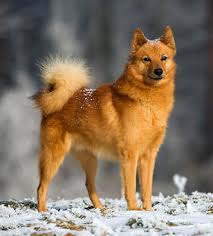
Finnish Spitz
Conditions of detention
Finnish Spitz dogs are adaptable and can live in various environments, from rural homes with large yards to urban apartments. However, they thrive best in settings where they can get plenty of exercises and mental stimulation. These dogs enjoy being active and need daily walks and playtime.
Useful Fact: They can be excellent watchdogs due to their alert nature and tendency to bark at unfamiliar sounds or visitors.
Nutrition and diet
A balanced diet is crucial for the Finnish Spitz’s health and vitality. High-quality commercial dog food that provides a balanced mix of protein, fats, carbohydrates, vitamins, and minerals is recommended. Fresh fruits and vegetables can be added for variety.
Useful Fact: Be cautious with treats and table scraps, as Finnish Spitz dogs can easily gain weight if overfed.
Health
The Finnish Spitz is generally a healthy breed, but like all breeds, they are prone to certain health conditions. Some of the health issues that may affect them include hip dysplasia, patellar luxation, and hypothyroidism. Regular veterinary check-ups and a healthy lifestyle can help mitigate these risks.
Useful Fact: Genetic testing for breeding dogs can help reduce the incidence of hereditary health issues in this breed.
Grooming and care
The Finnish Spitz has a beautiful double coat that requires regular grooming. Their coat is dense and stands off the body, with a soft undercoat and a harsher outer coat. The color is typically a reddish-gold, giving them their distinctive fox-like appearance. Brushing several times a week helps remove loose hairs and prevents matting, especially during shedding seasons.
Useful Fact: Despite their thick coat, Finnish Spitz dogs are relatively low-maintenance in terms of bathing, as their coat is naturally water-repellent and tends to stay clean.
Education and training
Finnish Spitz dogs are intelligent and independent, which can make training a challenge. Consistent, positive reinforcement training methods work best. Early socialization and training are essential to ensure they grow into well-behaved adults.
Useful Fact: Due to their hunting background, they may have a strong prey drive, so leash training and recall commands are particularly important.
Toys and entertainment
Finnish Spitz dogs are active and enjoy a variety of toys and games that challenge their minds and bodies. Fetch toys, interactive puzzles, and agility equipment can keep them entertained and mentally stimulated.
Useful Fact: They enjoy activities that mimic hunting, such as hide-and-seek games with treats or toys.
Safety
Because of their strong prey drive and tendency to wander, Finnish Spitz dogs should be kept on a leash or in a securely fenced area when outdoors. Supervision around small animals and birds is also recommended.
Useful Fact: A microchip and ID tags are essential for ensuring they can be returned if they get lost.
Accessories
A comfortable, sturdy harness is recommended for walks, as Finnish Spitz dogs are energetic and may pull on the leash. They may also benefit from a warm coat in cold weather due to their active nature.
Useful Fact: Reflective gear, such as collars and harnesses, can enhance visibility during evening walks.
Socialization
Early socialization is crucial for Finnish Spitz dogs. Exposing them to various people, environments, and other animals helps prevent shyness or aggression. Puppy classes and regular outings can be beneficial.
Useful Fact: Positive experiences during socialization can help reduce their natural wariness of strangers and unfamiliar situations.
Travel and Transportation
Finnish Spitz dogs generally travel well if introduced to car rides from a young age. Ensure their safety and comfort by using a secure crate or dog seat belt during car travel. Frequent breaks on long trips are important for their comfort.
Useful Fact: Familiarizing them with travel crates and carriers can make journeys less stressful.
Behavior and psychology
Finnish Spitz dogs are known for their lively, alert, and playful nature. They are loyal to their families but can be aloof with strangers. Understanding their independent streak and providing consistent training can help manage their behavior.
Useful Fact: They have a unique barking style, often referred to as “yodeling,” which is used to communicate with their owners, especially during hunting.
Legal aspects
Owning a Finnish Spitz requires understanding and adhering to local pet ownership laws, including leash laws, noise regulations (due to their barking), and registration requirements. Microchipping your dog is recommended for identification purposes.
Useful Fact: Some areas may have specific regulations regarding pet noise, so training to control excessive barking can be beneficial.


